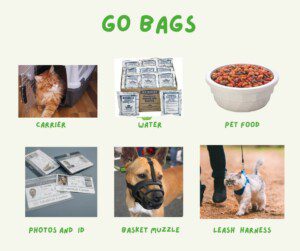La Niña is here and that means a hot, dry summer is approaching. We can never be too careful in preparing for fires here in the Sonoran desert.
Nearly all of Arizona is under a fire watch and that means lots of potential evacuations are approaching. Already, Prescott and Flagstaff are experiencing evacuations – often with less than 15 minutes warning to grab their pets and dearest belongings and leave their home.
Go Bags give us the opportunity to evacuate quickly and have everything we need for us and our pets for the next 24-36 hours. Go bags are easy to make and a must have with pets. You should have one for your cats, one for your dogs, and one for you and each family member.
Building A Go Bag for Pets:
When planning your go-bag, you need to ensure you have the following items included (some may include affiliate links):
Kennel or carrier
It’s good practice to store your go bag over your kennel or carrier. Instead of putting your carrier away in a hidden area your cats or other critters can’t reach, try to store it in the open where your cats can learn it’s a safe area. Cat carriers should be easily expandable (like this one) and if possible, rollable (like this one) to assist you in walking out of an area if it becomes necessary.
Water
Each go-bag should have enough clean, drinking water for your pet for 3 days. Fluid intake will vary according to where you live. In our desert, your pets will require quite a bit. A good rule of thumb is ½ – 1 oz per pound of bodyweight each day. If your dog is 15 lbs, you should plan on 10-15 ozs of water (about 1 pint per day.) If your cat weighs 15 lbs, you should have 15 ozs x 3 days in your go bag. 45 fluid ounces is equal to about 3 pints of water.
Bowls
Collapsible bowls will save you the most time and take up the least amount of area. We love these collapsible bowls (which also include lids), but there are many other types you may want to use.
Food
A high-quality canned food is best to keep in your go-bag as they can help a stressed pet obtain water when they don’t feel like drinking. This is especially important for cats.
Medication
If your pet is on any medication, be sure to have a three-day supply stocked in your go-bag. Each time you refill your medication, replace your stored access.
Leash/Harness
Your pets won’t want to stay in the kennel for three days (although it may be necessary). If your pet is leash-trained, you may want to add a walking harness and leash so they can get some time outdoors. When selecting one, be sure your pets can’t escape and that they are already adjusted to your pet’s size. You won’t have time to fumble around putting them on.
Identification
In the event you’re separated, be sure you have a copy of your pet’s ID (write down your microchip and rabies numbers). Pet Passports are easy to use and easily stored.
Photos
Keep a photo of you and your pets in your go-bag to prove ownership in the event you become separated. You may need this to identify or prove ownership of your pets. Remember that its’ likely you won’t be able to rely on your phones or other electronic devices at the time of emergency.
Treats
Having a small bag of your pet’s favorite treats can go a long way towards encouraging your pet to behave while you’re in a shelter environment. Most companies offer sample bags of their products – contact them and ask if they would send you treat samples as well.
Disposable litter box and litter
These eco-friendly, biodegradable litter boxes are ideal as they are lightweight, collapsible, and give your cat some privacy. There are also dozens of other types available, including those with pre-filled litter trays.
Basket Muzzle
Nearly every shelter or public transportation will require your pet (especially dogs) to be muzzled while staying. A basket muzzle is much less stressful to a dog (or cat) and will allow them to eat and drink comfortably.
Blanket/Comfort items
To keep your pets safe in a shelter environment it’s good to have things around that will help them relax. A blanket offers warmth and a place to hide, as well as the ability to expand your kennel for easy access to litterboxes and playtime.

How Much Can My Dog Carry?
Your larger pets can help ease your burden of carrying should you find yourself evacuating on foot. Most large dogs can comfortably carry their own food and supplies. Make sure they know how to wear a pack before an emergency.
Packs like these from Ruffwear are wonderful and allow your pets to easily carry their own food and supplies, and even have hydration bladders built into the pack. Make sure your dog’s pack is not too heavy and that they can easily maneuver in it.
Most dogs can easily handle 10% – 12% of their body weight (about 5-6 pounds for a 50-pound dog). This is a good starting point for how much they can carry. If your dog is accustomed to wearing a pack, you will get a feel for how much weight they can handle.
Remember that if your pets are walking, they need paw protection. Consider a good pair of hiking boots for your pets to shield their paws from the dangerous asphalt in Phoenix. You’ll want to make sure your dogs are familiar with boot wear.
We hope you never have to experience evacuation with your pets, but if you do, we hope you’ll be prepared! Emergencies don’t give notice, so make sure you have your pet’s (and your own) needs ready to go with a quick pack grab.

